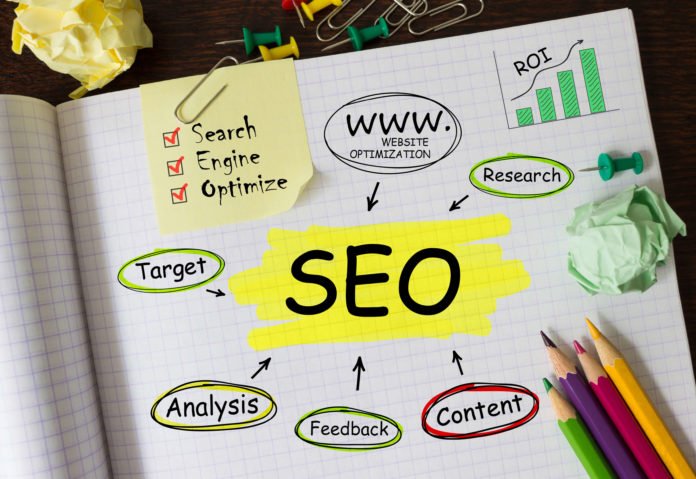One of the most common concerns among the owners of a corporate website is web positioning , since a large part of the success of its audience will be there. Reaching the target audience is not enough to have a website, but also to comply with some basic rules to optimize the tracking of robots by the contents of the published pages.
Main points for SEO, summary infographic
If you have a blog or a website where you usually publish articles periodically and you see that the audience cannot take off, you may need to rethink that you are preaching in the desert. Many times, despite complying with all the technical and editorial SEO requirements, it falls into the error of trusting them blindly and, although in the long run they will work, in the short term it is necessary to give them a boost with a social and participation strategy to induce traffic to our site.
Origin of the term SEO
SEO stands for the English words Search Engine Optimization or Search Engine Optimizer . This is to place our website in a high position in search engines, through a series of tactics, such as the inclusion of keywords, which help classify content.
In search engines , inclusion in organic search results is free, so even if paid advertising is included, it does not affect the web positioning obtained in the search engine .
Importance of having an SEO on your team
Including an SEO on your site can help improve it and save you time, although it can create an opposite effect than desired. That is why it is advisable to inform yourself and investigate, before hiring, the potential advantages of a well-made web positioning , and the prejudices that irresponsible SEO can offer on your site.
Review of site content and structure, assistance in website development, content development, management of online business development campaigns, keyword research, SEO training and experience in specific markets and geographic regions are some of the actions that they can offer us from the different SEO companies and other consultants and digital marketing agencies .
A good time to hire an SEO is when you are going to change the page design, or when you are in the process of creation, since this way it is easier to make sure that the page fits the parameters of the search engines. Although this does not have to be exactly like this, since you can hire an SEO keeping the same page, without needing to renew the existing one, with the intention of improving it.
How to avoid misuse of SEO
From the Google.com page they provide us with a series of recommendations to avoid a misuse of SEO that could harm the positioning of our website .
- You have to be wary of SEO agencies that send unsolicited Email marketing and its benefits.
- Be wary of agencies that guarantee first place in the Google ranking.
- Get advice on the methods and actions to be followed by agencies to position your website and be wary of those that do not clearly explain their intentions.
- Make sure you understand how SEO works , and know where you are investing your money.
The 22 essential points for SEO
-
Friendly source code
When designing or choosing a template for the web page to be published, special attention must be paid to ensure that the source code meets the accessibility, semantics and design requirements of W3C. Respecting the standards of the web, considering the range of browsers and fixed and mobile devices, will facilitate a better indexing of the content published on it, etc.
-
SEO On Page, frequent and quality content
The main mistake of most websites is that they lack content. On the Internet, it is not enough to have a page with the basic data of our company and a couple of photos. It is necessary to have a blog section in which you continuously write about our business and products. Content is the king of SEO and the websites that publish QUALITY articles regularly take the top positions of search engines.
-
SEO Off Page, quality links
It is essential for SEO to have recommendations from other good quality websites given the linkjuice . Therefore, our off-page SEO strategy must be focused on this. However, it is not enough to look for quality links, but you also have to tell Google not to ‘follow’ links on low-authority pages. For this I recommend you read our Guide on how to disavow links using disavow
-
Article recommendations
Since the introduction of Google’s Penguin algorithm , social networks have gained prominence when it comes to ranking pages in search results. The algorithm interprets that if an article has a high number of recommendations and comments, its content must be relevant and therefore must be highlighted in searches. In this way, the websites and blogs that have greater social activity and participation earn points in SEO positioning .
That is why it is not enough to prepare our websites to be ‘sociable’, but also, it is necessary to manage social activity in the most suitable networks for our interests and content.
-
Comments and participation in these
Separate mention has the comment tool. Many forums have echoed that there are more than proven reasons to claim that news that uses external applications to manage their comments, such as Facebook or Disqus tools , promote virality and also gain search engine rankings. The suspicion is most evident in the digital media that publishes breaking news.
Most search engines offer a news highlight, in which the first positions do not usually coincide with the most updated article, but in many cases corresponds to the one with the best information, and the way to assess quality is none other than evaluating its social impact and its participation rate in the comments .
-
User Ratings
Another variable that is gaining notoriety in the positioning of many web pages is the user ratings. In the digital world they are known as ‘reviews’, and for those who have a business website it is essential to enable and manage it. Both Google and Facebook offer tools to link a website to a ‘profile’ of your business where customers can assess their experience.
The hospitality union is the clearest example where evaluations are decisive for appearing in the first search results . Those hotels and restaurants that enable ‘reviews’ and manage the opinions of their clients, rise above the websites that are not linked to these tools. Where this SEO factor is most noticeable is in searches made from mobile devices, in which in addition to taking geolocation into account to offer you the closest business, the algorithms track user evaluations to highlight the business with the best reputation .
-
Site map
It is a list of the pages of our website, organized hierarchically to offer search engines a kind of index to the content. In this way, we make it easier for the search engine robot to navigate the web, indexing only what is desired, since it is possible to disable those pages that are not interested in being indexed, such as legal information. Here is a guide on how to deindex pages for dummies .
-
Metadata
They are descriptive tags that are incorporated into the web header to offer quick information on the web content, which are then used by search engines to offer the description of our website in the results list. It is therefore very important to spend some time customizing the ‘description’, ‘keywords’, ‘title’, ‘author’ tags for each page since the positioning of the contents in the search results depends largely on these variables.
Incidentally, images also have tags that must be filled with descriptions, as search engines also show results by images.
-
Correctly configure the .htaccess file
One of the most common problems of SEO positioning starts from an incorrect configuration of this file, for many unknown. This file, which is in the root folder of our page, allows for example the rewriting of the url of the page so that they are descriptive and thus avoid addresses with numbers and unintelligible characters. It also allows you to redirect deleted pages or domain changes without losing your previous positioning on our website.
-
Fast server
The loading time of a page is another variable that search engines penalize when positioning a website in its list of results. It is therefore important to choose a service provider that guarantees fast delivery of our website. Pages with a delay greater than 1 second suffer a positioning penalty.
-
Domain reputation
When choosing the domain, few are the ones who take the precaution of analyzing if that domain had a previous use. There are companies in charge of the massive purchase of domains with the sole objective of creating link farms and advertising at the expense of a brand’s reputation. These domains are immediately blacklisted from which it is very difficult to exit. Therefore, if your domain was recently released, be careful to analyze whether it has been penalized.
-
Pagerank
It is a variable that Google uses to measure the reputation of a website based on its content and the links it receives from other websites. In summary, the more links to our website for our content, the better reputation is achieved, and therefore, better positioning.
Working pagerank is a long-term task that consists of combining strategies for generating quality content, dynamization and social dissemination, and generating debate on other websites in our sector through the comments and social networks that feed our content and, above all, link and link without fear to other websites to generate ‘trackback’ that serve as a reference for those who read on those pages. The ultimate goal is to try to publicize our work to get external links that increase reputation.
-
Webmaster tools
Both Google and Bing have tools to improve the positioning deficiencies of our website. Its use is highly recommended since meeting the requirements they demand is a guarantee that our website will be properly tracked by their robots.
-
Analytical
Finally, all this work must be parameterized by an application that allows us to measure the traffic on our website and the origin of the accesses. Google offers its Analytics tool for free to be able to carry out the monitoring that will allow us to make decisions regarding the content or modification of other code variables.
-
GZIP compression
When compressing a document it weighs less, the same happens with web pages. With Gzip compression, pages weigh less and therefore load faster.
-
The type of server
There are many types of servers, and not all offer the same services. It is important to look at its storage capacity, the type of disk, the capacity of the traffic it has, its RAM capacity and the amount of data traffic that it supports.
-
Cache
Activating the cache memory allows you to store data on disk and then be able to use it again, which would speed up the loading of a website. Be careful with this, because the opposite can also happen.
-
Optimize resources
Resources such as images, videos or audios delay the load time, so it is important to optimize it. For example, images should never exceed 100KB.
-
Multimedia content in external services
If we use external services to host multimedia content, we will be reducing the server load.
-
Optimize the code
In this sense, the parameters to take into account for a website to load faster are the minification of the code to eliminate blank spaces and unnecessary bytes, separate the documents according to their “language”, compress the code and HTML, PHP documents …
-
Use CDN
Use a CDN that reduces the load on the server, allowing the web resources to be available from other servers hosted in other international locations.
-
Plugins
Regardless of the CMS used, care must be taken with the installed modules or plugins. Although they facilitate user navigation, having many modules can mean an increase in loading times.
-
Avoid penalties
If we are dedicated to managing and positioning web pages, one of the great doubts that will surely arise is knowing if our site has been penalized by Google . What does it mean to be penalized? How can I know if I have been penalized by Google? This deserves a new section.
Google penalties
The penalty we are referring to is a punishment imposed by Google towards our website. This usually happens when search engines notice something suspicious on our site, both “on page” and “off page”, measuring links, mentions and user metrics.
The main symptom of a Google penalty is the sudden drop in traffic on our website. If we observe overnight that our audience plummets, it is very likely that we have been sanctioned.
Now that we know what we are dealing with, we are going to distinguish between two different types of penalties, manual and algorithmic, as well as their submodalities.
Manual penalties
There are manual penalties that are imposed manually by a Google editor following your personal judgment . In this case, we will be notified in the Webmaster Tools ( Search Console ) by means of a notice in the form of a message informing us of the type of manual penalty we have suffered. Knowing the cause, we can act in consideration to correct this situation and later send a reconsideration to Google from our webmaster tools, leaving the decision to accept or reject it again in the hands of the editor.
Algorithmic penalties
In this case, they are penalties that occur automatically and usually coincide with the change of an algorithm. In this case we will not receive any type of notification in the Webmaster Tools (Search Console), so it will be more difficult to know the true reason for which we have been penalized, which can generate some confusion.
Within the algorithmic penalties, Google uses two tools that are responsible for carrying out these scheduled analyzes of web pages. They are better known as ” Google animals “.
-
Google Panda
Google Panda is in charge of quality, controlling and penalizing pages that do not have their own content and that copy content from other websites, that duplicate content from their own website, that translate content from other websites into their language, among other fraudulent behaviors.
-
Google Penguin
Google Penguin is concerned with avoiding artificial links, penalizing sites that make improper use of links, such as purchased links, poor quality or link exchanges. They defend the idea of having natural links, those that are created by users who really care about our content. This has implied that Google also takes into account Social Networks and other factors for SEO positioning .
Intrusive interstitial penalties
Since January 10, 2017, sites that show interstitials on mobile devices that prevent the user from accessing the content, will suffer a penalty. In this way Google intends to put a stop to the intrusive campaigns that prevent navigation. This update will result in penalties if any of the following techniques are used to prevent access to the content:
- Using pop-up windows
- Independent interstitials that must be closed to access content
- Formats that hide the main content at the bottom of the page
Google remembers that its main objective is to help users easily access content on mobile devices so that users quickly find the answer to their queries regardless of the device they are browsing with.
It is a further step in the strategy undertaken two years ago by identifying the sites that facilitated mobile navigation, avoiding the need to zoom in on content for reading on a mobile device.
Conversely, in some cases responsibly used pop-up messages will not be affected:
- Interstitials that appear in response to a legal obligation, such as the use of cookies or age verification.
- Login dialogs on sites where the content is not indexable . For example, this would include private content such as email or non-indexable content that is behind a paywall.
- Banners that use a reasonable amount of screen space and are easily disposable. For example, the app installation banners provided by Safari and Chrome are examples of banners that use a reasonable amount of screen space.
Penalties for not having a Responsive design
Searches for content from mobile devices continue to grow and threaten to monopolize the main bulk of access to web pages. The main search engines like Google, Bing and Yahoo, aware of this new typology of use and access to Internet content, try to adapt the search results to offer users a satisfactory experience to the device model used.
That is why the search results from a mobile phone differ from those obtained on a computer, since search engines have long been segmenting the results based on the usability of the websites from different access devices .
Therefore, if the contents of your website are not adapted to be consulted from a mobile device, your SEO positioning will be penalized by search engines, disappearing in searches made from mobile devices. There are many business and establishment pages that will soon be penalized in their positioning for not offering content adaptable to different devices.
From Google they urge to carry out this conversion by using pages with ‘responsive’ styles or with purely mobile alternatives such as AMP . All the websites that already comply with the new programming standards are already benefiting from a better location in searches made from mobiles and computers.
If you still do not know if your website meets the new requirements to be indexed correctly by search engines, Google offers a website where you can check what level of optimization your website has , and also offers possible solutions to correct your conversion to the mobile world. This is the Mobile Website Speed Testing Tool .
This is an easy tool to use. You only have to enter the address of your website to access the analysis and obtain an assessment of the ‘adaptability’ of your website. If the results are not satisfactory, the website provides the errors found and offers their possible solutions as well as a detailed and personalized report to correct them. Obviously, if your website is not ‘responsive’ or does not have an AMP version, you should consider completely changing your website or opting for an exclusive version for mobile devices.
From Google insist that it is important to carry out this adaptation in the coming months and, aware of the profound changes that must be made, they are not fully penalizing searches made from personal computers. However, as we indicated at the beginning, on mobile devices you can already notice the penalty if your website is not yet adapted.
How to know whether or not we have been penalized by Google
There are various tricks and tools by which we can know if we have been penalized or not. For example, we know of the existence of an online tool that shows us the traffic on our website in a quick and simple way, so that we can observe the behavior after each update.
All we need is to have a Google Analytics account on the website that we want to check. In this tool, in addition to being able to see the visits our site receives by means of a graph, the actions of Google Panda and Penguin will appear, making it very useful to know the behavior of the audience after the passage of these tools.
Mobile SEO of a website
More than half of Internet users browse through their mobile phones, a fact that companies often overlook when executing their digital strategy. Optimizing a website for viewing and handling on mobile not only improves the user experience, but also the SEO positioning of it, since Google takes into account whether the pages are adapted when ordering them in their results.
The search engine does not penalize non-adapted pages, but it is a favorable factor to position them higher than those that do not take this into account.
Here are some keys to having a website adapted to mobile phones and optimized for search engines.
Adapt web design to mobile
When we browse the Internet with our mobile, the experience we have when entering a page is very important, since it is not the same to do it on a page fully adapted to this device than to do it on one that has been exclusively designed for computer screens.
For this reason, even Google can show different results depending on the device on which the search is performed.
The responsive design allows the content to be viewed correctly regardless of the size of the screen, which is why it is the most recommended by Google so that a website also adapts to the mobile.
When having a mobile version, it is important to take into account aspects such as duplicate content, redirects, alternate media tags, specific sitemap, etc.
Web browsing on mobile must be fully optimized and focused. Some of the most important aspects are the text and the size of the CTAs, that the web design is consistent throughout the site or that the back buttons lead to the previous page and not to the home page.
If you want to know more about this topic I recommend the following article SEO optimized web design
Optimize speed
Another important aspect for positioning a mobile-friendly website for search engines such as Google is the page’s loading speed. In fact, if we seek to improve the user experience, it is vital that such web loading speed is as fast as possible, since otherwise they can even leave the page and search for another that loads faster. Clients’ time is always important. So much so, that Google released AMP .
Some tools like Google’s PageSpeed Insights let us know what loading speed a website has. This specifically allows us to know on a scale of 1-100 how fast the speed of a mobile website is and what we must improve to make it faster.
Images weight
To optimize the loading speed, it is important to take into account the size of the images that we use in its design, since smaller images speed up the web loading process.
Implement only the necessary redirects
We have to try to avoid unnecessary redirects and that the ones we use point directly to the destination URL, since each one increases the loading time by 0.6 seconds. Therefore, if our website has more than one redirect, it will load slower, for users and for search engines.
conclusion
As we have seen, there are many factors to take into account to have a good SEO positioning of our website or blog, including in-depth work on social networks. The advice given here to improve our web positioning has been rather technical, and can also be summarized in 6 points for optimization .
These have to be taken into account to position well, but as it is always said, although we know Google, everything has to be done for users, not exclusively it.
In the end what it is about is that the user experience when finding what you are looking for is as rewarding as possible. And for this, search engines begin to use subjective variables that ‘humanize’ the results based on the likes and comments of other users.
It is necessary to implement a management strategy for social activity on the web, networks and reviews to earn points in web positioning .













